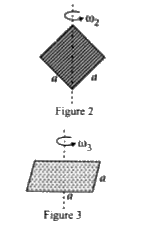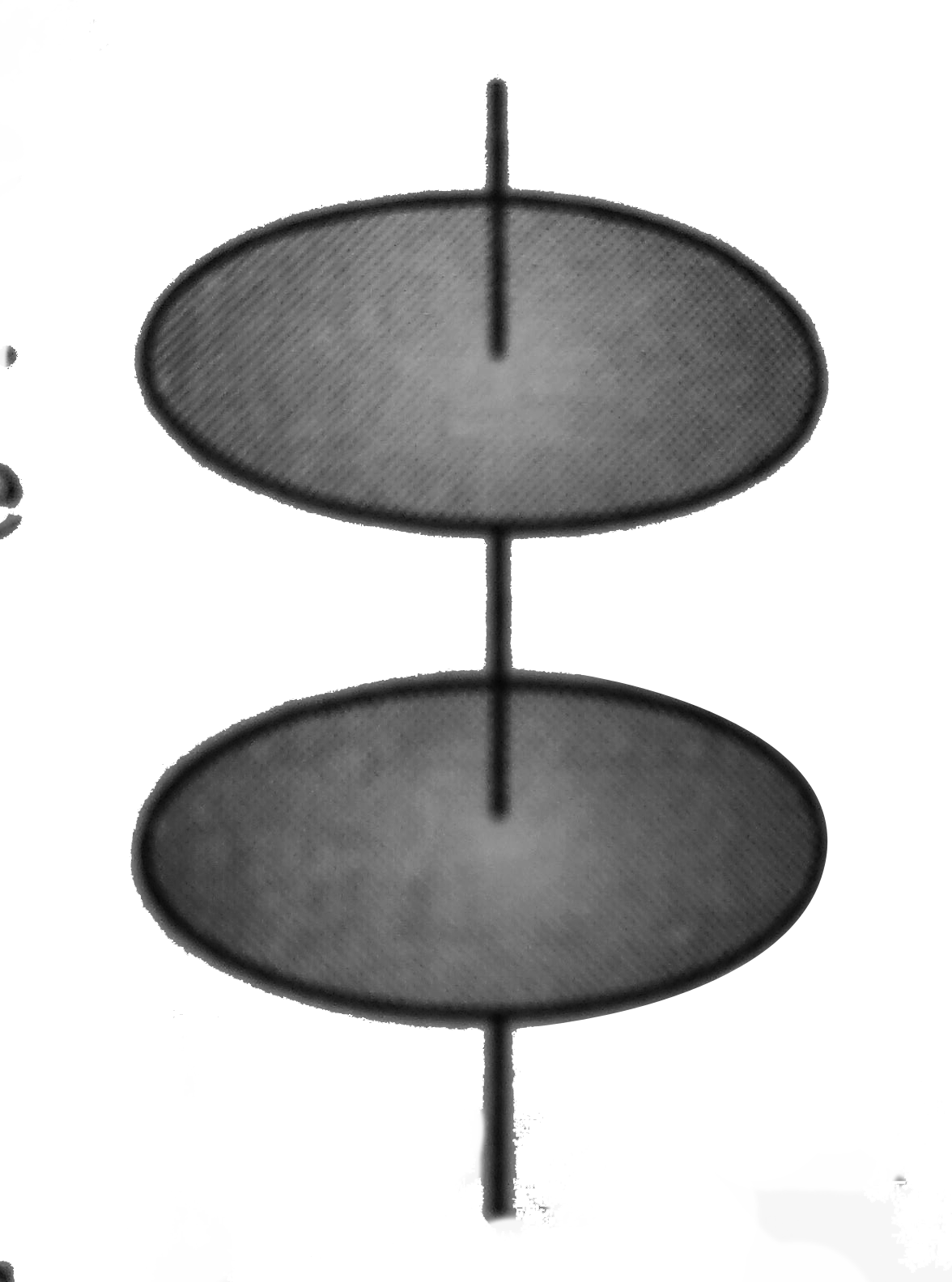Three identical square plates rotate about the axes shown in the figure in such a way that their kinetic energies are equal. Each of the rotation axes passes through the centre of the square. Then the ratio of angular speeds ω1:ω2:ω3 is

1:1:1
√2:√2:1
1:√2:1
1:2:√2
The correct Answer is:B
Kinetic energy of rotation, KR=12Iω2
or ω2=2KRI
Since KR remains the same for all three configurations,
∴ω∝1√l
Let m be the mass and a be side of each square plate
In figure 1, moment of inertia about the given axis,

I1=112ma2
In figure 2, moment of inertia about
the given axis,
I2=112ma2

In figure 3, moment of inertia
about the given axis
I3=16ma2
∴I1:I2:I3=1:1:2
As ω∝1√l
∴ω1:ω2:ω3=1:1:1√2=√2:√2:1
Topper's Solved these Questions
- MOTION OF CENTRE OF MASS, CONNECTED SYSTEMS, FRICTIONBook:MTG-WBJEEChapter:MOTION OF CENTRE OF MASS, CONNECTED SYSTEMS, FRICTIONExercise:WB-JEE WORKOUT (CATEGORY 2 : Single Option Correct Type (2 Marks))
Explore 25 Videos
- MODEL TEST PAPTER Book:MTG-WBJEEChapter:MODEL TEST PAPTER Exercise:MCQs
Explore 80 Videos
- NUCLEAR PHYSICBook:MTG-WBJEEChapter:NUCLEAR PHYSICExercise:WB JEE PREVIOUS YEARS QUESTIONS
Explore 5 Videos
Similar Questions
Two discs of moments of inertia I1andI2 about their respective axes (normal to the disc and passing through the centre), and rotating with angular speed ω1andω2 are brought into contact face to face with their axes of rotation coincident . What is the angular speed of the two-disc system ?
View SolutionTwo discs of moments of inertia I1andI2 about their respective axes (normal to the disc and passing through the centre), and rotating with angular speed ω1andω2 are brought into contact face to face with their axes of rotation coincident (i) What is the angular speed of the two-disc system ? (ii) Show that the kinetic energy of the combined system is less than the sum of the initial kinetic energies of the two discs. How do you account for this loss in energy ? Take ω1≠ω2.
View Solution
Knowledge Check
A solid cylinder of mass M and radius R rotates about its axis with angular speed ω. Its rotational kinetic energy is
A12MR2ω2BMR2ω2C14MR2ω2D18MR2ω2A solid cylinder of mass M and radius R rotates about its axis with angular speed ω. Its rotational kinetic energy is
A12MR2ω2BMR2ω2C14MR2ω2D18MR2ω2Two discs of moments of inertia I1 andI2 about their respective axes (normal to the disc and passing through the centre), and rotating with angular speeds ω1 andω2 are brought into contact face to face with their axes of rotation coincident. (a) What is the angular speed of the two-disc system? (b) Show that the kinetic energy of the combined system is less than the sum of the initial kinetic energies of the two discs. How do you account for this loss in energy? Take ω1≠ω2
ADoes the law of conservation of angular monentum apply to the situation ? Why ?BFind the angular speed of the two disc system .CCalculate the loss in kinetic energy of the system in the the process.DAccount for this loss.
A solid sphere of radius r and mass m rotates about an axis passing through its centre with angular velocity ω. Its K.E. Is
View SolutionA solid sphere of radius r and mass m rotates about an axis passing through its centre with angular velocity ω. Its K.E. Is
View SolutionA solid square plate is spun around different axes with the same angular speed. In which of the following choice of axis of rotation will the kinetic energy of the plate be the largest?
View Solution
Two identical discs are positioned on a vertical axis as shown in the figure. The bottom disc is rotating at angular velocity ω0 and has rotational kinetic energy K0. Change in the rotational kinetic energy of the system is
View SolutionThe kinetic energy of an object rotating about a fixed axis with angular momentum L=Iω can be written as.
View Solution
